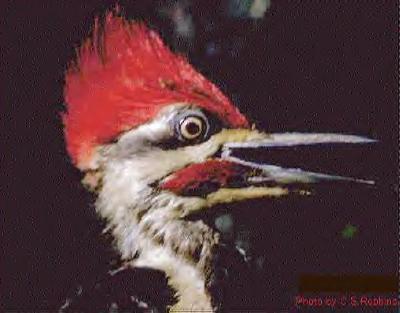|
|
Canku Ota |
|
|
(Many Paths) |
||
|
An Online Newsletter Celebrating Native America |
||
|
March 24, 2001 - Issue 32 |
||
|
|
||
|
Why Coyote Stopped Imitating His Friends |
||
|
Caddo Legend |
||
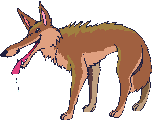 Coyote and
Raven were good friends. One day after Coyote had grown weary of hunting for food and finding none, he decided
to go to the top of Blue Mountain to see his friend Raven. "Welcome," Raven said. "But why do you
look so weary and sad, my friend?" Coyote and
Raven were good friends. One day after Coyote had grown weary of hunting for food and finding none, he decided
to go to the top of Blue Mountain to see his friend Raven. "Welcome," Raven said. "But why do you
look so weary and sad, my friend?" "I have been hunting for food," replied Coyote, "but I found nothing." Upon hearing this, Raven put an arrow to his bow and shot it straight up into the air, and then stood waiting for it to come down. It came down and pierced his upper wing. When Raven drew the arrow out, it had a large piece of buffalo meat fixed to the head. Raven gave the meat to Coyote, who smacked his mouth and ate heartily. "That was a fine piece of meat," Coyote said. "I must repay you some time. Will you come and visit me soon?" "Yes, I will come," promised Raven. Coyote did not know that Raven possessed magic powers over the buffalo, and he believed that he could perform the same trick to obtain meat. In expectation of Raven's visit, he made himself a new bow, and a few days later Raven came down from Blue Mountain to see him. "Welcome, welcome," Coyote greeted him. "I have no meat because I did not expect you, but if you will wait a moment I will soon have some for you." 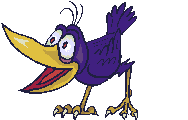 Coyote took his new bow and shot an arrow straight up into the sky. He then stood waiting for it
to come down. Raven watched him but said not a word. The arrow came down and struck Coyote's thigh. He ran away
screaming with pain, leaving his guest behind. Raven waited a while and then went home without any meat, but in
very high spirits because Coyote's attempt to imitate him amused him greatly. For days he chuckled to himself whenever
he thought of it. Coyote took his new bow and shot an arrow straight up into the sky. He then stood waiting for it
to come down. Raven watched him but said not a word. The arrow came down and struck Coyote's thigh. He ran away
screaming with pain, leaving his guest behind. Raven waited a while and then went home without any meat, but in
very high spirits because Coyote's attempt to imitate him amused him greatly. For days he chuckled to himself whenever
he thought of it. As for Coyote, he ran for miles until he finally had the sense to stop and pull the arrow out of his thigh. He was so humiliated that he broke the arrow to pieces, and then wandered off and hid in the woods. After a time he grew hungry, and when he could find nothing to eat he decided to go up on Rich Mountain and visit Brown Bear. "Welcome, old friend," said Brown Bear. "I will see if I can get some food to offer you." As he spoke he leaned against a persimmon tree that was weighted down with ripe persimmons. His body jarred the tree so that the ripe fruit fell to the ground. Bear smiled and asked his friend to eat. Coyote ate persimmons until he was no longer hungry, and then he filled his pack with them. "Thank you, indeed, my friend," said Coyote. "I must be going now, but I insist that you promise to visit me soon."  Next day Coyote wandered all about looking for a persimmon tree. He could not find one with any
fruit on it, and so he cut down one without fruit. He carried it home where he set it up. Then he took the persimmons
he had brought in his pack and tied them to the tree branches so that they looked as though they had grown there. Next day Coyote wandered all about looking for a persimmon tree. He could not find one with any
fruit on it, and so he cut down one without fruit. He carried it home where he set it up. Then he took the persimmons
he had brought in his pack and tied them to the tree branches so that they looked as though they had grown there.
Not long after that, Brown Bear came by to make his promised visit. "I am glad to see you," said Coyote. "Wait a moment and I will try to get you something to eat." Coyote began bumping against the persimmon tree with his head. He butted harder and harder but the persimmons were tied on so well they would not fall off. Finally he shook the tree with his paws, although it embarrassed him to have to do this. He gave the tree a big shake and over it fell, crashing upon his head. He pretended that it did not hurt and went about gathering up the fruit for Bear, but he could hardly see for the pain. The knot on his head kept growing larger and larger. 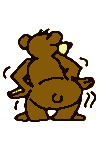 Bear ate, but he could scarcely swallow for laughing at the way Coyote had tried to imitate him. After a while he told Coyote that it was time for him to leave. He was afraid to stay longer for fear Coyote would see him laugh. After Bear left, Coyote sat down and held his sore head, but he felt happy because he had furnished food for his friend Brown Bear. A few days later while Coyote was out in the forest looking for something to eat, he came upon a grass lodge that he had never seen before. Wondering who might live in the new lodge and if they might have some food to share with him, he went right up to the entrance and called out: "Hello in there. I'm Coyote." "And I'm Woodpecker," a voice replied. "Come in." Coyote entered and saw a bird walking around with a bright light on his head. "Say, friend," cried Coyote, "your head is on fire, and you and your house will burn up if you don't put it out." The Red-Headed Woodpecker smiled and replied in a calm voice: "I've always worn this light on my head. It was given to me in the beginning. It will not burn anything." Woodpecker then gave Coyote something to eat.  After Coyote had eaten all he could, he arose and said that he must go. "Please come over and make me a visit," he said, "and I shall return your hospitality." Some time later Woodpecker visited Coyote's lodge. "Is anybody home?" he called out at the entrance. "Just a moment," replied Coyote. Woodpecker could hear him rustling around inside, and then Coyote said: "Now, come in and be seated." 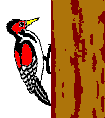 Woodpecker entered and was surprised to see a bunch of burning straw on Coyote's head. "Oh,
take that off," cried Woodpecker. "You will burn your head." Woodpecker entered and was surprised to see a bunch of burning straw on Coyote's head. "Oh,
take that off," cried Woodpecker. "You will burn your head." Coyote smiled and replied in a calm voice: "No, no, that will not burn my head. I always wear it. I was told in the beginning that I would wear a light on my head at nights so that I can do whatever I like while others are in darkness." Coyote had no more than finished speaking when the hair on his head caught fire. He began to scream in pain and tried to put it out, but could not. He ran out of his lodge, howling all the way to the river. Woodpecker waited a long time for him to return, but Coyote stayed in the river all day trying to soothe his burned head. After that, Coyote stopped trying to imitate his friends. |
|
Print and Color Your Own Woody Picture: |

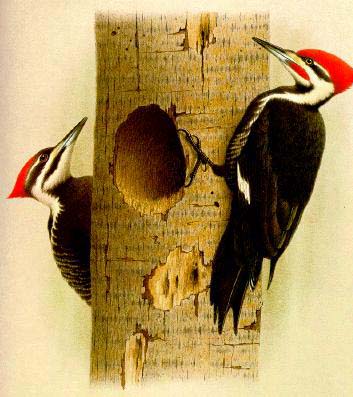 The Pileated
Woodpecker (Dryocophus pileatus) is one of the most interesting birds of North America. Its large, awkward head
shape, bright colors, and unusual call make it an exciting bird to encounter in the woods. However, this bird is
rarely seen, because it stays concealed. Pileated Woodpeckers are cool birds. Woody Woodpecker was a Pileated Woodpecker.
The Pileated
Woodpecker (Dryocophus pileatus) is one of the most interesting birds of North America. Its large, awkward head
shape, bright colors, and unusual call make it an exciting bird to encounter in the woods. However, this bird is
rarely seen, because it stays concealed. Pileated Woodpeckers are cool birds. Woody Woodpecker was a Pileated Woodpecker.